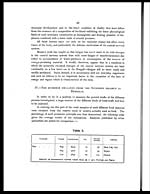Medicine - Institutions > Army health reports and medical documents > Scientific memoirs by officers of the Medical and Sanitary Departments of the Government of India > Number 34 - Standards of the constituents of the urine and blood and the bearing of the metabolism of Bengalis on the problems of nutrition > Standards of the constituents of the urine and blood and the bearing of the metabolism of Bengalis on the problems of nutrition
(41) Page 33
Download files
Individual page:
Thumbnail gallery: Grid view | List view

33
From the evidence of differences in the chemical composition of the blood
enumerated above it may be fairly deduced that the diet—poor in nitrogen—is the
cause of the changes. The blood in chronic underfeeding does not as a rule
show any very great variations in composition, as it is able to maintain its com-
position more or less normal even under very adverse circumstances; but the
changes that do occur are all of the same type as we have shown are to be found
in the blood of the Bengali. Von Hoesslin states that chronic underfeeding
influences the total volume of the blood, as well as the mass of all the tissues,
and produces individuals who are poorly supplied with blood, fat and muscle.
We may, therefore, conclude that, so far as the evidence obtained from the
blood is concerned, the Bengali falls short of the standard of the European in
this respect also. His nitrogenous tissues are not given the option of drawing
their nutritive material from so rich a source, nor have they the same opportunity
of obtaining as free a supply of the all-important life-sustaining oxygen.
There is no deficiency in the absolute number of the red and white cells of the
blood; but more or less similar conditions have been found in the blood of the
several professional fasters during the periods of their fast. This, as far as one
can say, would appear to be an effort on the part of the cell-forming tissues to
maintain the composition of the blood as nearly normal as possible—in this way
attempting to make up for the deficiency in hæmoglobin and proteid elements.
The increased salinity of the blood, which we hold is ever an accompanying
feature of anæmia, is present also in the anæmia of the Bengali and is probably
the explanation of the increase in the coagulability, alkalinity and specific gravity.
How far these different conditions may be explained by an inspissation of the
blood—an oligæmic rather than an anæmia condition—is a question that cannot at
present be decided.
While it is impossible to state dogmatically that these different factors
are due to the insufficient supply of proteid in the food it would appear to be the
most plausible, and, as far as the facts go, the only explanation.
We think we are justified in saying that a people, on a diet containing only
37.50 grammes of proteid, live in a more or less chronic state of nitrogenous
starvation leading to a loss of body-fat and tissue-proteid with the inevitable result
of loss of vigour and strength and a comparatively low capacity for prolonged
or sustained muscular effort. We shall have further evidence to produce with
regard to the comparative strength and power of performing work of the Euro-
pean and the Bengali; at present it will be sufficient to say that the latter in this
respect falls far short of the former—up to, in many instances, as much as from 60
per cent. to 75 per cent. This is not due to any deficiency in the energy-producing
carbohydrates and fats, for, as we shall show later, their diet is very rich in the
carbohydrate elements. We hold, on the other hand, that it is due to a lack of
F
Set display mode to: Large image | Zoom image | Transcription
Images and transcriptions on this page, including medium image downloads, may be used under the Creative Commons Attribution 4.0 International Licence unless otherwise stated. ![]()
| Permanent URL | https://digital.nls.uk/75032357 |
|---|




